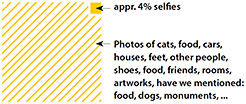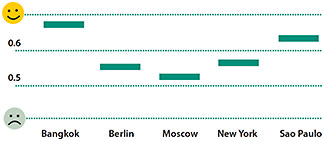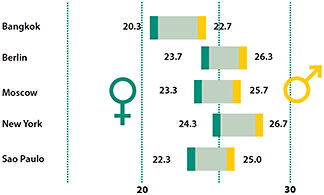FRAME-FITTING TECHNOLOGY
Selling Frames in a Selfie Universe
Today’s frame consumers are never not shopping…so become a savvy seller by utilizing retail technology
BY AMY SPIEZIO

it’s a duckface, trout pout world out there as consumers pose and post their way to new purchases using technology as their fitting room and buying guide. The selfie culture is at its high point, with selfie named as Word of the Year by Oxford Dictionaries in 2013, bringing popular awareness and saturation to a trend that started in the young, tech-savvy universe.
The modern consumer spends his or her days and nights with his or her tech connections—from smartphones to tablets to laptops—always close at hand. They are using them for work and play and all sorts of commerce. Often, these devices can be seen in your shop, and whether patients are taking selfies or Instagramming their favorite looks, tech is part of their talk.
Naturally, this interest is soaking through to the other side of the cash register, too. According to “Embracing Mobile Devices in Retail and How to Manage them Effectively,” a white paper by Kaseya Mobile Device Management, “Retailers are increasingly embracing mobile services and applications to better engage with customers on the showroom floor and improve the customer experience.”
When it comes to frame fitting and sales, this technology opens new doors and provides new opportunities to connect with consumers.
HARDWARE STORES
Entering the dispensary these days, patients bring more than their Rx’s. “A lot of our customers walk in and are familiar and educated on their order already,” says Oakley’s retail Rx category manager, David Blenkle, who was on hand recently to help introduce the company’s first in-store optician at Oakley’s Fifth Avenue flagship store in New York City.
With a condensed dispensing area, space is at a premium. And with a tech-smart market to help, portable, practical tablets are a major player in the dispensary. Oakley’s Jimmy Ocelli, LDO, does most of his Rx eyewear and sunwear fitting with an iPad. “We have shrunk all of the dispensing tools into a smaller device,” he says.
This trend is on the upswing overall in retail, notes the Kaseya report. “Fifty-two percent of retailers are planning to roll out tablets to their employees in stores within the next 12 months. Another 25 percent plan to roll out tablets in the following 12 months.”
Equipping practices brings up some pressing questions, particularly for small, independent businesspeople with little to no IT support. Before implementing iPad usage in-store, subjects to consider include what the devices’ function should be in each dispensing situation and how your practice will control its iPad inventory (see Tech Agreement sidebar).
TRYING IT ON FOR SIZE
Just how far you take your device utilization in terms of the dispensing experience will vary with your practice management software, your technical comfort level, and your interest in engaging patients with next-level technology. One of the most impactful options for frame sales is try-on technology, with which users can test-drive their eyewear selections on the web.
In terms of fitting technology, there are two main options: real-time try-on and virtual try-on tools. Real-time try-on is typically an in-office option, helping high myopes and those with dilated eyes “see” what they actually look like in their eyewear via a screen.
Though this technology is utilized by about 80 percent of European opticians, ABS/SmartMirror’s Fabian Bruneau, director of U.S. operations, says it has been slower to take hold in the U.S., with about 40 percent of optical dispensaries utilizing try-on technology. “If you go to LensCrafters, they have an app, they are professional retailers. The independents in the U.S. are eye doctors and they are trying to operate a business and they are fighting against retailers. If you’re not using something like this, you’re not giving a shopping experience.”

Above: The new Oakley flagship store on Fifth Avenue in New York City is the first to host an on-staff optician. To provide quality, interactive fitting, the majority of disensing is done digitally. Left: Using an iPad to fit eyewear with an ABS/SmartMirror app
This technology, available in app form for uploading to tablets and smartphones, can help pull the dispensing experience into a format with which today’s online shoppers are comfortable, adds Bruneau.
“It’s a great tool to communicate with the patient,” he says. “There’s nothing virtual—patients will try on the frames they will buy. The app will take pictures and you can show four frames; you can also shoot four-second videos. They know exactly what they are going to look like and there will be less buyer’s remorse.”
The other option is virtual reality. Most programs use photos uploaded by the end user/potential buyer to create a 3D model of his or her face which is then outfitted with a variety of frame styles. “Virtual reality is great at home. It’s good for pre-shopping,” Bruneau says.
Offering this means ECPs need to be aware of their inventory and give these buyers a pathway to try on what is available in their practice. Ideally, this will be located on a practice’s app and website for easy shopping.
GETTING APP-TIVE
So you have your iPads in place and your try-on program selected. The next step is to make sure your patients have a place to interact with your bells and whistles. Increasingly that means an app. Though websites are still strong, a recent Small Business Administration (SBA) webinar panel, “Making It Big: Small Biz Success in a Mobile World,” explored the idea that apps are the wave of future for small businesses.
“You want to have presence where people are,” says Matthew Mahoney, vice president of business development with Booker, a reservations site similar to Open Table but focused on local services providers. “People have their phones with them all the time and check their phones 150 times a day. So, if it was five or six years ago and you’re a business and you want to be present where customers are, you want to show up in search engines. Today it’s more apps and you want to show up in app stores. You want to be on the device they carry all the time and you want your logo to be the thing they see; maybe not 150 times a day, but they might see it 100 times a day.”
While many of us see apps as fun gadgets and games, apps have an increasingly relevant role in the livelihood of small businesses. This umbrella of potential definitely covers optical, as apps can host anything from try-on technology to appointment setting. At the SBA webinar, Li-at Karpel Gurwicz, vice president of marketing for Como, an app development and marketing firm, says that apps help you build business and relationships with your customers.
“We see your app as an integral part of your business,” she notes. “And what you want to do is build a community of your loyal customers who are using your app and who know your business and who want to get the value that your business is already providing to them. You want to be giving them things that they really need and are also helping your business through the app. So if you’re a spa, you want to get your appointments done through the app; if you’re a florist you want to manage your deliveries through the app.”
Selfie Centered
The blog SelfieCity.net explores the phenomena of selfies in cities around the world, including Berlin, Bangkok, Moscow, Sao Paulo, and New York.
Comparing a one-week sampling of posted images in the five cities, Selfiecity’s creators developed a thumbnail sketch of selfie shooters, focusing on the subjects of their photos (hint: New Yorkers AREN’T the grumpiest selfies in the world), the likelihood of smiling in their self-portraits from city to city, and the gender mix of the selfie images.
Along with research findings on the digital self portaits, SelfieCity has released the following data about the narcissistic snaps.
ONE IN 25 PHOTOS IS A SELFIE

AVERAGE SMILE SCORES

WHO TAKES SELFIES? MEDIAN AGES PER CITY AND GENDER


Are you introducing iPads or tablets or other smart tools into your practice? Now might be the time to adopt an employee technology agreement to ensure everyone is on the same page with usage policies. The following form was adapted from the Virginia State University Employee iPad Agreement. Customize it for your own use. A PDF version is available at EyecareBusiness.com.
EMPLOYEE IPAD AGREEMENT
• I understand that this iPad is _____________________ property and is for my use while employed at ______________________, and as such I will use this device in a responsible manner and in accordance with practice policies.
• I understand that as the iPad is the property of _________________, I have no expectation of privacy regarding the device or its contents. I will return the iPad to _____________________ when requested.
• I will take appropriate steps to protect the iPad and data against loss or theft.
• I will accept financial responsibility for the loss or theft of the device and the disclosure of information resulting from my failure to take appropriate steps to protect the iPad.
• I will not jailbreak or otherwise tamper with the iPad operating system.
EMPLOYEE ACKNOWLEDGEMENT
I have read and agree to be bound to the terms of this Agreement. I understand that I could be held financially responsible for the loss or theft of the device and the disclosure of information should I fail to take appropriate steps to protect the device and its contents in accordance with this agreement.
Printed Name ___________________________________________
Signature ______________________________________________
Date: _________________
iPad No. _______________

Patients are actively involved in the online universe for shopping and socializing. Image courtesy of Selfiecity
GETTING ENGAGED
Try-on technology and its supporting apps and hardware provide something critical for today’s consumers: engagement.
Notes Michael Francisco, senior developer marketing manager for Amazon, “You need to be in front of your customers all of the time.”
He cites the following data to show just where those customers will be:
• About 156 million people use a smartphone, with users increasing yearly by about 24 percent.
• About 82 million people have a tablet, with users increasing yearly by about 37 percent.
He adds, “The most interesting stat that sits on top of that is about 80 percent of the time that people engage with retailers on their devices happens through an application, not through mobile web. Most of your opportunities for engaging with customers on those mobile devices, and it’s a huge ecosystem of people, is through applications.”
What’s important to focus on when developing an app? “Making yourself be present, so they can find you,” Francisco notes. “Making it easy to use so they enjoy engaging with your app, and then making sure it’s an extension of solving a problem for them will really help you grow your business using applications.”




